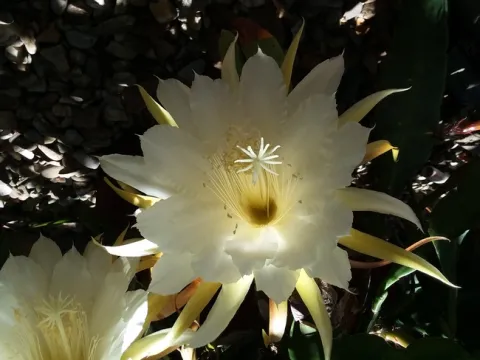
Orchid Cactus
by Polly Nelson UCCE Master Gardener
Epiphyllum, family Cactaceae
Planting area: Sunset 8-9, 14-24
Size: blooms up to 10-inch diameter
Bloom Season: Spring-early summer; daytime-blooming flowers
Exposure: Partial shade, bright indirect light
Pruning needs: Minimal
Water needs: Regular
Snapshot:
This nondescript plant with flat, segmented stems (leaves) produces amazing flowers, in colors ranging from white and yellow to reds and purple. Originally from the Central American tropical rainforest, it is a cactus, but similar to an orchid, it sustains itself by absorbing nutrients from the air. It grows well in hanging baskets and containers, indoors or outdoors and in the ground. Honeybees, butterflies and other pollinators are attracted to the blossoms, which last from 1-4 days. This plant is easily propagated from stem cuttings.
Plant in soil that holds moisture but drains quickly. Allow the top one-third of the soil to dry out between waterings; about once a week spring through fall, less often in the winter. Soft black tissue near the soil line is a sign of too much water.
Light to dark green growth with slightly red edges indicate the plant is getting the right amount of light. If the leaves are sunburned or have yellowish wilted growth, it is getting too much light; weak leggy leaves suggest insufficient light. Plants grown indoors need to have no light after sundown or blooming will be delayed. Orchid cacti do not tolerate freezing temperatures, preferring 40-90 degrees Fahrenheit.
Fertilize monthly during the growing season (February-November) with a low nitrogen fertilizer (2-10-10) following label instructions. Generally, this plant likes to be root-bound before it will bloom, but it should be repotted one month after blooming at least every 7 years. Shake off excess soil to repot, but do not remove all the soil around the root ball. Withhold water for a week after repotting, then water lightly for a month before returning to a regular watering schedule.
Fungus gnats are one of the few pests of this plant. Snails and slugs can do a lot of damage if they gain access to the plant.
Orchid cactus plants grown in the right place require little effort, and reward with spectacular blooms!

